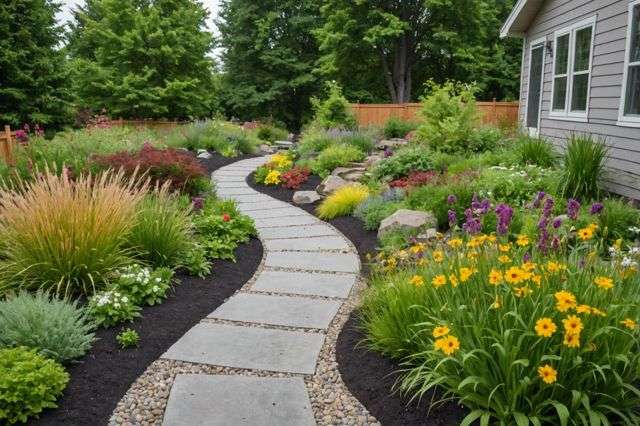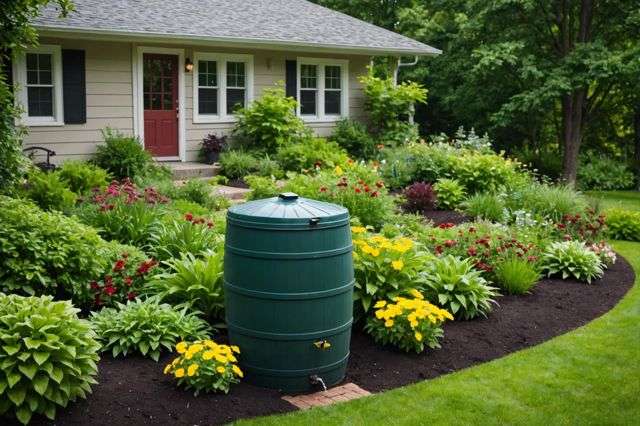Backyard Remodeling in Culver City (2024 Edition)
- #Exterior Remodeling
- #General Remodeling
- #Outdoor Living

- Smooth Plaster Finish
- Shimmering Pebble Finish
Backyard remodeling in Culver City in 2024 focuses on creating watershed wise landscapes to conserve water and enhance local ecosystems. Key steps include using native plant species, implementing efficient irrigation systems, and employing rainwater capture techniques to sustain an eco-friendly outdoor environment.
Understanding Watershed Landscaping Principles
In this article, we simplify the official document that is available on Green Gardens Group website.
- Watershed landscaping integrates design with ecology, aiming to conserve water and support local ecosystems.
- Key principles include capturing rainwater, using permeable materials, and planting native species that require less water.
- Benefits of watershed landscaping include reduced water usage, enhanced local biodiversity, and improved soil health.
- Techniques such as contouring land to manage water flow and using mulch to retain soil moisture are effective.
- Choosing the right plants is crucial; opt for those that are adapted to local climate conditions and require minimal water.
- Regular maintenance such as mulching, weeding, and monitoring irrigation systems is necessary to sustain a healthy landscape.
- Engaging professionals can help in designing and maintaining a landscape that adheres to watershed principles effectively.

Step-by-Step Guide to Creating a Watershed Wise Landscape
Transforming your backyard into a watershed wise landscape is a smart way to conserve water and create a beautiful outdoor space. Here’s a simple guide on how to achieve this:
- Soil Management: Start by testing your soil to understand its type and condition. Use organic methods like adding compost and mulch to improve soil health. This helps create a living soil that acts like a sponge, absorbing and retaining water efficiently.
- Plant Selection: Choose plants that are suited to your local climate and soil conditions. Opt for native or climate-appropriate plants as they require less water and are more resistant to local pests and diseases.
- Water Use: Implement efficient irrigation techniques such as drip irrigation systems that deliver water directly to the roots where it’s needed most. Consider installing a rainwater capture system to make use of natural rainfall, reducing the need for supplemental watering.
- Practical Tips:
- Mulch your garden beds to reduce water evaporation.
- Group plants with similar water needs together to optimize irrigation.
- Regularly check and maintain your irrigation system to ensure it operates efficiently.
By following these steps, you can create a sustainable and attractive landscape that contributes positively to the environment.
Selecting the Right Plants for Your Garden
When choosing plants for your garden in California, consider plants that are suited to the local climate. This includes those that can thrive in dry conditions and those native to the area. Here are some tips:
- Select Native Plants: Opt for species that are native to California as they are adapted to the local climate and require less water.
- Consider Drought-Resistant Varieties: These plants need minimal watering once established, saving you time and reducing water usage.
- Plan for Different Seasons: Some plants do well in dry summers and others in wet winters. Make sure to choose varieties that can handle both.
- Group Plants by Water Needs: Organize your garden so that plants with similar watering needs are together. This makes watering more efficient.
- Use a Hydrozoned Layout: Design your garden in zones based on water requirements to conserve water and reduce maintenance.
By following these guidelines, you can create a sustainable garden that conserves water and is easier to maintain.

Innovative Techniques for Water Management
Managing rainwater creatively in your landscape can make your garden both beautiful and functional. Here are some effective techniques for water management:
- Rain Gardens: These are shallow depressions that collect rainwater from your roof, driveway, or street and allow it to soak into the ground. Planted with grasses and flowering perennials, they not only manage water but also enhance the beauty of your yard.
- Swales: These are shallow channels that can be disguised as dry stream beds or planted ditches. They direct water away from buildings and toward areas where it can be absorbed naturally by the soil.
- Permeable Paving: Instead of traditional concrete or asphalt, use paving materials that allow water to filter through and reach the soil underneath. This reduces runoff and helps replenish groundwater.
- Rain Barrels and Cisterns: Install these systems to capture rainwater from your roof. Use the stored water for irrigation, which saves you money and reduces your reliance on municipal water systems.
Each of these techniques not only helps manage water efficiently but also turns your yard into an eco-friendly space that contributes to the sustainability of your community.

Maintaining Your Watershed Friendly Garden
Maintaining a garden that supports your local watershed requires some specific care techniques. Here are some tips to keep your watershed friendly garden thriving:
- Seasonal Care: Adjust your garden care with the changing seasons. In dry periods, make sure your garden is efficiently using every drop of water. During wetter months, ensure proper drainage to prevent waterlogging.
- Pest Management: Use natural methods to manage pests. Introduce beneficial insects that prey on harmful pests and use organic pesticides if necessary. This helps maintain the natural balance of your garden without harsh chemicals.
- Garden Techniques:
- Mulching: Keep a layer of organic mulch around plants. This helps retain moisture, suppress weeds, and adds nutrients back into the soil as it decomposes.
- Composting: Add compost to enrich the soil. Healthy soil supports plant health and helps in water retention.
- Proper Planting: Choose native or climate-appropriate plants that naturally thrive in your area. This reduces the need for additional water and fertilizers.
- Water Management: Implement systems like rain barrels or a rain garden to capture and reuse rainwater. This not only saves water but also reduces runoff into the local watershed.
By following these guidelines, your garden will not only look great but also contribute positively to the local environment.

FAQ
What are the key principles of watershed landscaping?
Watershed landscaping integrates design with ecology, focusing on water conservation and support for local ecosystems. Key principles include capturing rainwater, using permeable materials, and planting native species that are low-water requiring.
What are the steps to create a watershed wise landscape in my backyard?
To create a watershed wise landscape, start by managing your soil health, selecting climate-appropriate plant species, and implementing efficient water use techniques such as drip irrigation and rainwater capture systems. Practical steps include mulching, grouping plants with similar water needs, and maintaining your irrigation system regularly.
How should I select the right plants for a drought-affected area like California?
Choose native plants or those adapted to California’s local climate which are usually drought-resistant. Plan for the seasonal variations and arrange plants according to their water needs using a hydrozoned layout to make your garden water-efficient and easier to manage.
What innovative techniques can I use to manage rainwater in my garden?
Consider creating rain gardens, utilizing swales, installing permeable paving, and setting up rain barrels or cisterns. These techniques help reduce runoff, manage water use efficiently, and enhance the aesthetics of your garden while being sustainable.
How can I maintain a garden that supports the local watershed?
Maintaining a watershed friendly garden involves adjusting your garden care according to the seasons, managing pests using natural methods, and applying garden techniques like mulching, composting, and proper planting. Also, implement water management systems like rain barrels or a rain garden to optimize water usage and reduce runoff.
What benefits can I expect from adopting watershed landscaping principles?
By adopting watershed landscaping principles, you can expect reduced water usage, enhanced local biodiversity, improved soil health, and a garden that not only looks good but also contributes positively to the environmental sustainability of your community.









